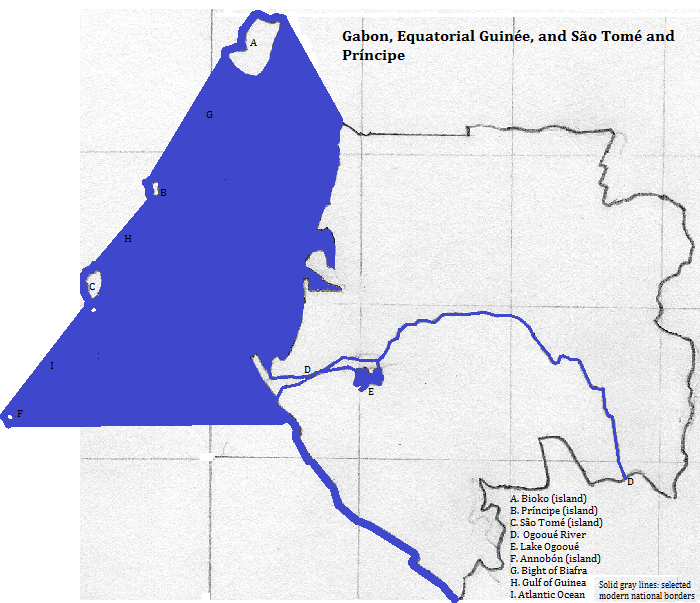
| To Duval Family Home Page | Africa |
| To Chris Home Page | |
| To Earth (Geography Home Page) | |
This area is a very irregular square of Africa, bounded west by the Gulf of Guinea, plus some islands. The mainland has a swampy coast, with several lagoons and estuarial river mouths. Beyond the mainland the land rises in steps to forested plateau. Several short rivers flow west off the plateau; the Ogooué system drains much of Gabon. The largest freshwater lake is a spill lake off that river.
Of the islands Bioko is the largest, and sits southwest off Cameroon. It is simlarly mountainous. São Tomé is next largest, and next tallest. Príncipe is the third largest island.
The only UNESCO World Heritage Site honors both nature and culture: Ecosystem and Relic Cultural Landscape of Lopé-Okanda.

More than three in four of the less than three million people speak Northwest Narrow Bantu languages. More than one in ten speak Western African languages, and about one in ten speak Indo-European languages or creoles. Of individual languages, Fang
Some proportion between six in ten and three in four are Christian, with Roman Catholics three fourths of those. Most of the rest follow local religions.
The only city with as much as half a million people is Gabon's capital, Libreville. Port Gentil is the most important port.
Bantu speakers arrived starting 4,000 years ago. Two routes were followed: inland and by sea. The sea route went to Bioko and the Gabon estuary. By the 14th or 15th century B.C.E., Fang speakers had arrived in the inland areas. They moved coastward in the 19th century, modifying the local Eboga religion.
around Bioko and Principe, and west of Rio Muni and northern Gabon
north of Rio Muni and northeast Gabon
east and south of Gabon
around Annobon, south of Sao Tome and west of southern Gabon
north of Sao Tome, and northwest of Cap Lopez, Gabon
1. Equatorial Guinea in English.
2. Also called Fangwe, Mpangwe or Pahouin.
3. Many Christians practice the Ebonga religion as well; these numbers may thus be an artificial divide of a belief continuum.
4. P. Burabe, La religion d'Eboga ou le Bwitides Fanges, 1982, translated by William J. Gladstone, 1997, and published on www.ibogaine.org/barabe.html (viewed 3/2006).